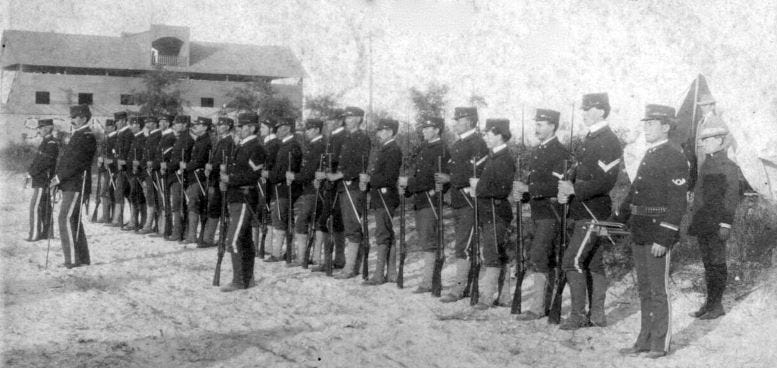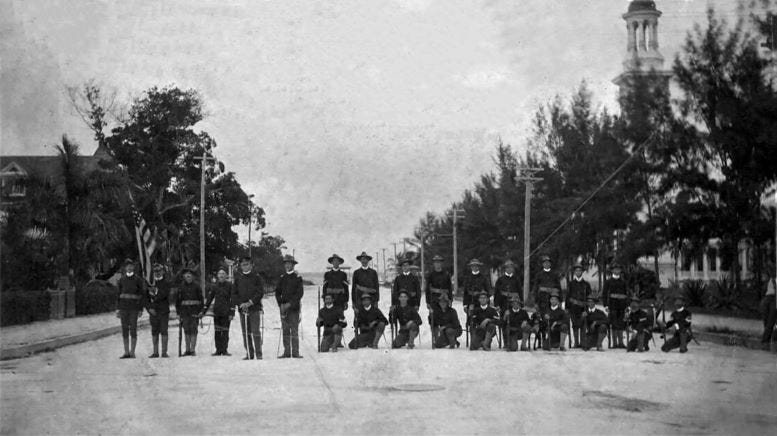Miami Rifles – Company L
The first Florida national guard unit in Miami was established on May 1, 1901, as Company L of the Second Battalion Infantry, nicknamed the Miami Rifles.

At the end of the Spanish American War in 1898, during which Miami served as a training ground for nearly 7,000 troops, several influential Miami pioneers petitioned the Florida’s Governor William Bloxham to establish a state militia in the young city of Miami. While the city was only a couple of years old at the time, the local residents felt a permanent military presence would provide security for the municipality needed following a war that took place just a couple hundred miles to their south.
Although it took a couple of years of lobbying and a change in governor, Miami was awarded a national guard company in 1901. William Jennings, who assumed the governorship that same year, had ties to the Miami area and likely was the reason that such a small municipality at the time was awarded a national guard unit. This is the story of Company L of the Second Battalion Infantry, which was fondly nicknamed the ‘Miami Rifles.’
Formation of Company L in 1901

Company L was officially formed on May 1, 1901, and the unit’s first captain was one of the organizers of the petition to get the governor’s approval for a state militia in Miami. Prior to becoming the company’s first captain, James T. Sanders was a county prosecutor who argued cases at the Dade County courthouse when it was located in Juno and after it was relocated to Miami in 1899. In the first five years after the county seat returned to Miami, the courthouse operated out of what would later become a fish house along Avenue D, today’s South Miami Avenue, and the Miami River prior to moving into the county’s first permanent courthouse in Miami which opened in 1904 on today’s Flagler Street.
In addition to Sanders being appointed captain, the other officers were Elbert A. Froscher, the first lieutenant; Charles Miller, second lieutenant; Joseph Chaille, first sergeant; and James F. Jaudon as second sergeant. The training for Company L consisted of weekly drills in and around Miami. The first armory was on the grounds of the aforementioned courthouse near the Miami River.
Captain James T. Sanders was influential in the formation of the first criminal court established in Miami. From the time of incorporation in 1896 until 1905, when a change in the charter provided for the creation of the office of municipal judge, the sitting mayor served as the local judge in criminal cases. Sanders was the first municipal judge elected under the new provision and served in that role from November 1905 until November 1909. He would later become the Dade County solicitor until he retired from that position in 1914.
James F. Jaudon - Captain from 1903 - 1907

James Sanders served as the leader of Company L for a little more than two years after the formation of the unit. Perhaps given his ambition and effort to become a local judge, or for some other reason, Sanders stepped down from his role as captain for the company in the fall of 1903. Sargeant James F. Jaudon was promoted to captain on December 5, 1903.
Jaudon arrived in Miami in the fall of 1895, nearly a year before the incorporation of the city, where he engaged in trucking in Allapattah. He was the driving force behind the construction of the road from the Royal Palm Golf course to Allapattah. He later became the county tax assessor and helped form special tax districts for extending roads to what were remote areas of South Florida at the time. However, Jaudon may best be known for his association with the Chevelier Corporation and being one of the catalysts behind the completion of the Tamiami Trail into Miami.
During Jaudon’s role as the ranking officer for Company L, the unit became known as the ‘Miami Rifles.’ It is unknown how the unit got this moniker, but they would routinely be seen marching and running drills in and around downtown Miami in preparation for inspection and competition. It is likely that the nickname was given by local residents who would watch the unit conduct their drills, a show of marching with rifles.
After Jaudon took over the unit, the Miami Rifles accepted invitations to partake in statewide, and even national competitions to showcase their training such as marching, combat skills, physical fitness and marksmanship. In 1904, Company L was selected to attend a joint army and militia encampment at Manassas, Virginia, as a member of the First Florida Provisional Regiment, National Guard of Florida, and was selected as the best drilled company at that encampment.
It was not by accident that the Miami Rifles were some of the best trained national guardsman in the state. Every weekend, the men of Company L marched down Twelfth Street from the county courthouse, proceeded east until they reached Royal Palm Park where they conducted drills. Early residents would go to the park to watch the Miami Rifles drill as a form of entertainment.
Keep reading with a 7-day free trial
Subscribe to Miami History to keep reading this post and get 7 days of free access to the full post archives.




